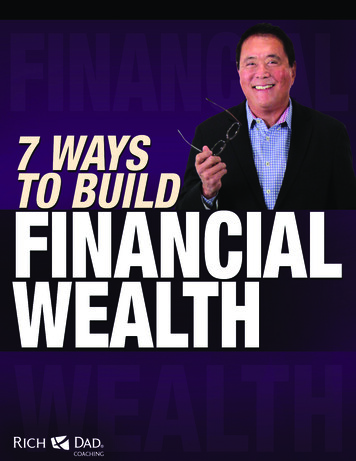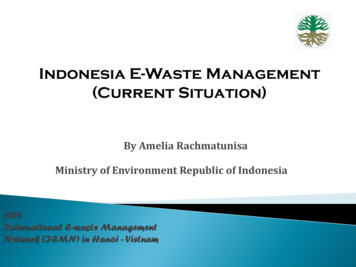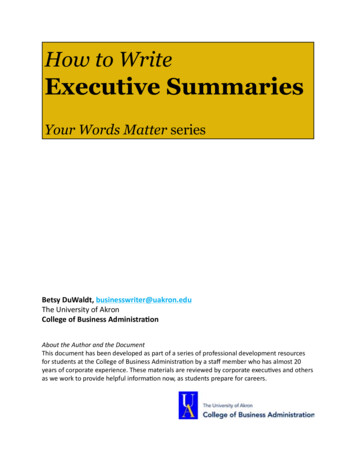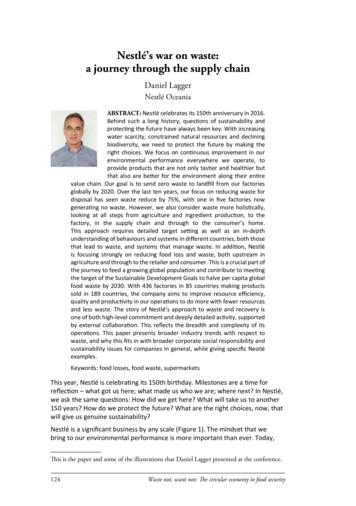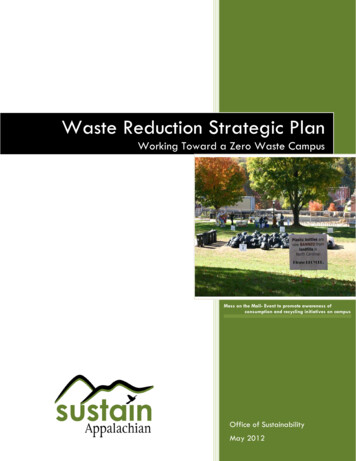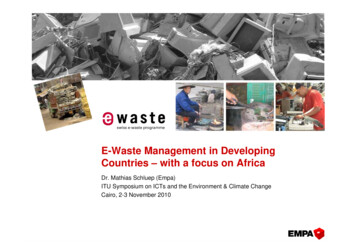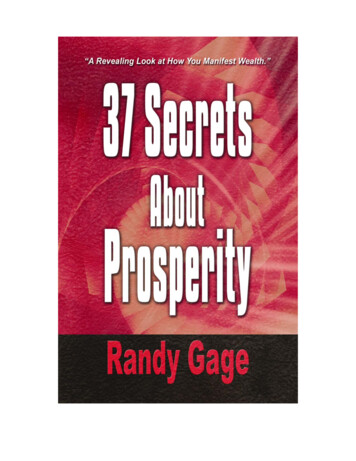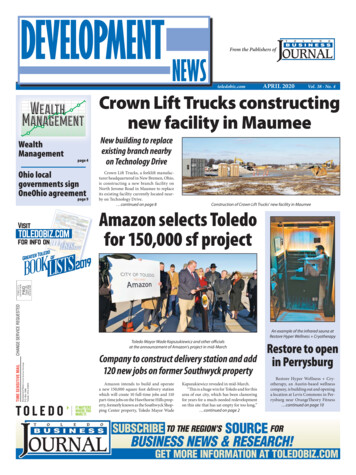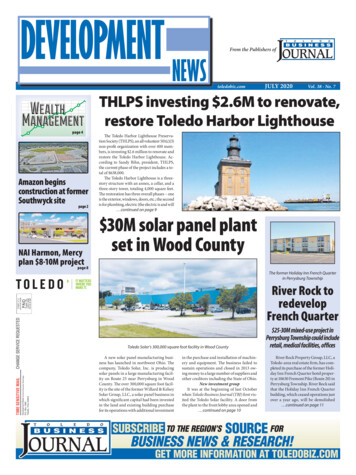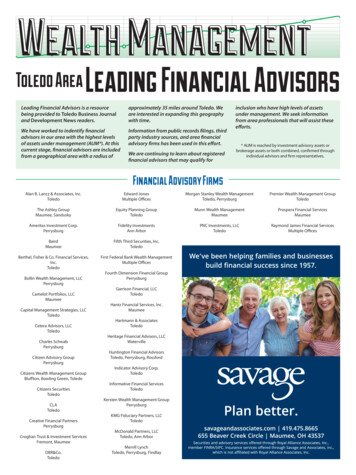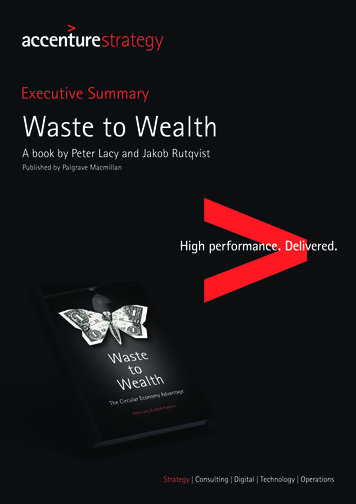
Transcription
Executive SummaryWaste to WealthA book by Peter Lacy and Jakob RutqvistPublished by Palgrave Macmillan
ContentsIntroduction3Five circular economy business models4Ten disruptive technologies6Driving the circular advantage7Getting started7Moving to take, make, take, make, take, make7
IntroductionTransitioning to the circular economy may be the biggest revolution and opportunityfor how we organize production and consumption in our global economy in 250years. At its essence, the circular economy represents a new way of looking at therelationships between markets, customers and natural resources. And the lens throughwhich it’s viewed is disruptive to new business models powered by new technologybreakthroughs, in particular digital.How? Digital disrupts the way we produce and consume through innovative businessmodels established by innovative technologies. Blended together, the circulareconomy, innovative new business models and digital revolution represent a hugeopportunity for companies to create a competitive advantage, or as we put it,a “circular advantage.”In fact, our research indicates a 4.5 trillion reward forperforming circular economy business models by 2030. That’snot just waste in the traditional sense of rubbish, but thesignificant underutilization of natural resources, products andassets. It’s about eliminating the very concept of ‘waste’ andrecognizing everything has a value. It’s about moving fromefficiency to effectiveness in the way we manage inputs andoutputs. And by forging a much deeper bond with consumers.Going beyond point of sale, to create connections throughproduct returns and customer engagement.Unlocking 1 billion in previously wasted value by transformingmaterial management in manufacturing? Or using a country’sunderutilized biomass resources to tap into an 80 billion marketfor advanced chemicals and energy?Global industry leaders as well as innovative start-ups arealready beginning to reap huge rewards by tapping into theseopportunities. And it’s just the beginning. Waste to Wealth mapsout how they’re doing it and what other leaders can learn asthey create their own circular advantage.What about creating a 10 billion business renting propertywithout using any energy, metal or other resources to build asingle house? Increasing a company’s gross profit by 50 percentwhile reducing material use by 90 percent, all by recovering andremanufacturing used components?3
Five circular economy business modelsWe hope to transform the circular economy from an abstract concept into an easy-to-understand,practical and applicable business model for you. But at a practical level, making the shift is not thateasy. Most companies are simply not built to automatically capitalize on the opportunities the circulareconomy offers. Their strategies, structures, operations and supply chains are deeply rooted in thelinear approach to growth—it’s in their DNA.Companies seeking the circular advantage will be required todevelop new business models that are free of the constraintsof linear zero-sum thinking. In the book, we describe the fivemain circular business models that Accenture has identified inits analysis of more than 120 companies that are generatingresource productivity improvements in innovative ways.1This means shifting from merely selling things to actively keepingthem alive and relevant. It also means moving customers fromtransactions to relationships, tailoring upgrades and alterationsto specific needs. Through its refurbishment business, Dell Inc.Computers takes back old equipment and resells units whenpossible.4These models’ abilities to help companies enhance differentiation,reduce cost to serve and own, generate new revenue and reducerisk—as well as their impact on the rules of resource supplyand demand—are the core contributions of this book.4. Sharing Platform1. Circular Supply-ChainWhen a company needs resources that are scarce orenvironmentally destructive, it can either pay more or findalternative resources. The Circular Supply-Chain introduces fullyrenewable, recyclable or biodegradable materials that can beused in consecutive lifecycles to reduce costs and increasepredictability and control. One example: CRAiLAR TechnologiesInc., a company that produces renewable biomass resourcesusing flax and hemp to create fibers as good as cotton withoutthe environmental impact.22. Recovery & RecyclingThe Recovery & Recycling model creates production andconsumption systems in which everything that used to beconsidered waste is revived for other uses. Companies eitherrecover end-of-life products to recapture and reuse valuablematerial, energy and components or they reclaim waste andby-products from a production process. Like Procter & GambleCompany (P&G)—the company operates 45 facilities on a zerowaste basis.33. Product Life-ExtensionConsumers discard products they no longer value—becausethe products are broken, out of fashion or no longer needed.But many of these products still hold considerable value, andthe Product Life-Extension model seeks to recapture it. Bymaintaining and improving products through repairs, upgrades,remanufacturing or remarketing, companies can keep themeconomically useful for as long as possible.4In developed economies, up to 80 percent of the things stored ina typical home are used only once a month.5 The Sharing Platformmodel—increasingly assisted by new forms of digital technology—forges new relationships and business opportunities for consumers,companies and micro-entrepreneurs, who rent, share, swap orlend their idle goods. Fewer resources go into making productsthat are infrequently used, and consumers have a new way toboth make and save money. Examples include Uber Inc., AirbnbInc. and Lyft Inc. among a growing field.5. Product as a ServiceWhat if manufacturers and retailers bore the “total cost ofownership?” Many would immediately adjust their focus tolongevity, reliability and reusability. When consumers lease orpay for products by use through the Product as a Service model,the business model fundamentally shifts—in a good way.Performance trumps volume, durability tops disposability, andcompanies have an opportunity to build new relationships withconsumers. Koninklijke Philips NV is using “lighting as a service”to charge by output instead of unit sales.6Adoption of these five circular business models has grownsubstantially in the past decade, even if we are still at thefoothills of the coming changes. Initially, circular business modelinnovation was driven by start-ups. Now, large multinationalsare making serious moves as well—as illustrated by a jointAccenture and United Nations Global Compact study, whichfound one-third of global CEOs actively seeking to employcircular economy models.7
Figure 1: The five circular business modelsPRODUCTDEVELOPMENTCCYUPE/CLCYRED TOLAR ATSTE SUPPLIER E G E NEAC TU R ENANUFURR EMETB UI LLERSSOURCINGUR BR EFI S H / R E MA R K E TMANUFACTURING/ REUS E/ EXCHACONSTARTSELLGER E US EAR EP IR / UR AD ER EFIL/PGLDISPOSALRETRADERRE TUNMARKETING& SALESPRODUCT USEBUSINESS MODELSCURRENT VALUE CHAINCIRCULAR SUPPLY-CHAINPATHRECOVERY & RECYCLINGDIRECTIONPRODUCT LIFE-EXTENSIONSHARING PLATFORMPRODUCT AS A SERVICE5
Ten disruptive technologiesNew business models offer companies powerful options for embracing the circular economy. But itwould not be possible to scale many of these business models without the support of 10 innovativetechnologies. Digital innovations in social, mobile, analytics, cloud and machine to machinecommunication (M2M) are especially effective in connecting physical and digital channels, andin connecting customers more broadly and deeply than ever before.1. Mobile6. Modular Design TechnologyMobile technology spurs adoption of circular business models byenabling universal and low-cost access to data and applications.As consumption behaviour goes mobile and online, it reduces theneed for physical resources ranging from paper and entertainmentto stores.Modular design technology is not only revolutionizing howproducts function but also the length and nature of customers’relationships with those products. When a modularly designedproduct breaks, only the defective part is replaced or repaired,keeping the product relevant to its users longer and extendingits overall product lifecycle.2. Machine-to-Machine (M2M) CommunicationMachines capable of communicating with one another are notnew. M2M technology has long been used in factory controlsystems and vehicle telematics. But we’re about to reach acritical mass for mainstream M2M use as wireless networkcoverage expands worldwide.3. Cloud Computing7. Advanced Recycling TechnologyWhile recycling is not at all new, it has benefited from a greatdeal of innovation and some significant, rapid returns on circulareconomy investments. Because of the advances in recycling, andits increased efficiency, more and more companies are turning tothe circular economy as a source of growth.Dematerialization—the process of replacing something physicalwith a digital alternative—has placed entire industries on theendangered species list (think travel agents, music stores andnewspapers). Cloud computing is key to dematerialization, alongwith mobile and social technologies.8. Life and Material Sciences Technology4. Social9. Trace and Return SystemsWhile social media started as a way for people to find and connectwith friends and family, it has evolved into so much more. Socialtechnology is foundational to sharing. It reduces the cost ofsetting up sharing platforms as it allows businesses to tap intoexisting networks such as Facebook . It makes it cheaper andquicker for companies to receive consumer feedback to helpimprove offerings.8Trace and return systems support circular business models bymaking it more cost-effective to collect used products to service,repair, recover, reuse, refurbish or recycle them—for example,through efficient and effective material sorting machines.5. Big Data AnalyticsIn the circular economy, many companies will generate theirrevenues from product use instead of sales, and growth will relyon how good they are at understanding and catering to productuse behaviour. This means companies need to monitor and analysedata in entirely new ways. Complex analytics is especiallyimportant for the Circular Supply-Chain, Sharing Platform andProduct as a Service business models.6Life and material sciences play a key role in driving inputsubstitution at a large scale. Ongoing innovation in this fieldwill lead to new circular material input options. It will also bringon new ways to alter outputs so they can be used as inputs.10. 3D PrintingArguably one of the most-hyped technologies of the past fewyears, 3D printing is steadily evolving to become a major playerin the manufacturing world. It has also become one of the majordrivers of circular business models. It facilitates repairing bymaking it possible to directly print suitable parts with the exactgeometry. It also creates opportunities for circular inputs, inputsthat are biodegradable or infinitely recyclable.
Driving the circularadvantageThe book explores what’s helping to drive successin the circular economy and explores howwinning companies: Carefully choose the business model that is right for theirbusiness, recognizing there is no one “right” answer for allcompanies to succeed in the circular economy. In implementingnew circular business models, they make sure to identify andcapitalize on external enablers and business ecosystems. Secure access to key facilitating technologies to support andscale new business models and use those technologies toeffectively manage resources within markets, confirm waste iseliminated and monetized, serve customers and drive businessand product development over time. Develop capabilities that effectively deploy and operatecircular business principles. We describe five distinct capabilityshifts that help companies to create a circular flow fromproduct design to production, retail, product use, take-backand profitable regeneration and reuse.Getting startedWhile the case for change is clear and there isconsiderable urgency to start making the moveto circular business models, many companies stillwrestle with how to get started.They’re stuck in “pilot paralysis,” trying to understand what’sscalable and what’s not. For those organizations, we offer asimple framework that can help them assess this challenge. Wepresent a set of strategic options executives at any organization,regardless of industry, can use to begin a move towards thecircular economy. And argue that ultimate success hinges onfive important initial actions:1. Identifying and concentrating on the actual opportunity(as opposed to the noise).2. Rethinking how value is created and delivered to customers.3. Putting in place a focused set of new capabilities (and nottrying to implement the ‘perfect’ circular setup, at least notinitially).4. Investing in technology to make value chains circular.5. Timing the balance between capturing near-term, lowhanging fruit and engendering long-term, large-scalechange.Moving to take, make, take, make, take, makeTransforming towards a circular economy meansa shift from the old school approach of “take,make, waste” to “take, make, take, make, take,make.” The transition may take time and effort.That’s why a proactive strategy for how andwhen to make the move is critical.To perform a circular advantage, the first step is to clearlyunderstand the motives for abandoning the current linear modeland the benefits that circular business models offer—includingthe technologies and capabilities that are critical to success.For companies wanting to future-proof their growth agenda, thecircular economy and circular advantage are the places to look.And there’s never been a better time to start.
Join the conversation@AccentureStratContact the authors:Peter LacyGlobal Managing DirectorSustainability, Accenture Strategypeter.lacy@accenture.comJakob RutqvistManagerSustainability, Accenture Strategyjakob.rutqvist@accenture.comReferences1 Drawing on primary and secondary research, Accenture analyzed more than120 case studies on companies representing a wide range of geographiesand industries, with the most prevalent being companies in Europe or NorthAmerica and in the textile, high-tech and apparel industries.2 CRAiLAR website, http://www.crailar.com/revolution accessed September 9,2014, but this link is not working anymore, please see p:/www.crailar.com/revolution.About AccentureAccenture is a global management consulting, technologyservices and outsourcing company, with more than 336,000people serving clients in more than 120 countries. Combiningunparalleled experience, comprehensive capabilities across allindustries and business functions, and extensive research onthe world’s most successful companies, Accenture collaborateswith clients to help them become high-performance businessesand governments. The company generated net revenues ofUS 30.0 billion for the fiscal year ended Aug. 31, 2014.Its home page is www.accenture.com.About Accenture StrategyAccenture Strategy operates at the intersection of businessand technology. We bring together our capabilities in business,technology, operations and function strategy to help our clientsenvision and execute industry-specific strategies that supportenterprise wide transformation. Our focus on issues related todigital disruption, competitiveness, global operating models,talent and leadership help drive both efficiencies and growth.For more information, follow @AccentureStrat or visitwww.accenture.com/strategy3 Dr. Forbes McDougall, ‘From waste to worth—zeroing in on waste’, Inside P&G,accessed September 9, 2014, http://www.pg.com/en UK/news-views/InsidePG-Quarterly Newsletter/issue8/sustainability.html.4 “Dell using carbon neutral and closed-loop recycled plastics in packaging,parts,” Plastics News, May 21, 2014.5 Yerdle website, “Shop Freely,” accessed November 21, 2014,https://yerdle.com/about.6 SustainableBusiness.com, “Philips Introduces ‘Lighting as a Service,’”January 23, 2014, ws.display/id/25461.7 United Nations Global Compact and Accenture, “The UN Global CompactAccenture CEO Study on Sustainability 2013: Architects of a Better World,”September 2013, balcompact-ceo-study-sustainability-2013.8 Accenture, “Accenture Technology Vision 2013: Every Business Is a DigitalBusiness,” ision-2015internet-me-video.Origami Design by Won ParkCopyright 2015 AccentureAll rights reserved.Accenture, its logo, andHigh Performance Deliveredare trademarks of Accenture.This document makes descriptive reference to trademarks that may be owned byothers. The use of such trademarks herein is not an assertion of ownership of suchtrademarks by Accenture and is not intended to represent or imply the existenceof an association between Accenture and the lawful owners of such trademark.
underutilized biomass resources to tap into an 80 billion market for advanced chemicals and energy? Global industry leaders as well as innovative start-ups are already beginning to reap huge rewards by tapping into these opportunities. And it’s just the beginning. Waste to Wealth map
